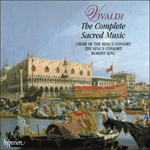If any sacred work by Vivaldi deserves to be described as his ‘most perfect’, it is Domine ad adjuvandum RV593. Its short text—half a verse from Psalm 69 (70) plus the Doxology—is a response (or ‘respond’) to the versicle ‘Deus in adjutorium meum intende’, with which Vespers open. RV593 belongs to the group of large-scale works in due cori dating from the 1720s. The words from the Psalm, occupying the opening movement in G major, are dispatched in choral writing of great panache—nowhere does Vivaldi exploit the antiphonal potential of a double choir and orchestra to greater effect. The urgency conveyed by the word ‘festina’ (‘make haste’) is admirably captured in the phrases tossed from choir to choir. In contrast, the ‘Gloria Patri’ is an ecstatic solo in E minor for a soprano threading her (originally, no doubt, ‘his’) way between the two continuously dialoguing instrumental ensembles. The final part of the Doxology is an introduction and fugue for united cori. Its two sections are knit together by the presence of continuous quavers in the instrumental bass. Initially at walking speed, these break into a canter for the fugue, which demonstrates almost ostentatiously Vivaldi’s ability to create a number of invertible counter-subjects, each of which can suitably act as a bass to the others.
from notes by Michael Talbot © 1997
S’il est une œuvre de Vivaldi qui mérite d’être décrite comme «la plus parfaite», c’est la Domine ad adjuvandum RV593. Son texte court—un demi-verset du psaume 69 (70), plus la doxologie—est une réponse (ou un répons) au versiculet «Deus in adjutorium meum intende», qui inaugure les vêpres. Le RV593 appartient à l’ensemble d’œuvres à grande échelle a due cori, des années 1720. Les paroles psalmiques, qui occupent le mouvement d’ouverture en sol mineur, sont déployées dans une écriture chorale toute de panache—nulle part ailleurs Vivaldi n’exploite avec plus d’effet le potentiel antiphonal d’un double chœur et orchestre. L’urgence véhiculée par le mot «festina» («hâte-toi») est admirablement saisie dans les phrases échangées de chœur à chœur. A contrario, le «Gloria Patri» est un solo extatique, en mi mineur, pour une (à l’origine, sans aucun doute, «un») soprano se faufilant entre les deux ensembles instrumentaux, en dialogue permanent. La dernière partie de la doxologie est une introduction et fugue pour cori unis. Ses deux sections sont soudées par la présence de croches continues dans la basse instrumentale. Initialement sises à une allure nonchalante, elles se font petit galop pour la fugue, qui démontre presque avec ostentation la capacité de Vivaldi à créer un certain nombre de contre-sujets réversibles, chacun pouvant convenablement servir de basse pour les autres.
extrait des notes rédigées par Michael Talbot © 1997
Français: Hyperion Records Ltd
Wenn überhaupt ein geistliches Werk Vivaldis als „sein perfektestes“ bezeichnet werden kann, dann definitiv dieses Domine ad adjuvandum RV593. Sein kurzer Text—ein halber Vers aus Psalm 69 (70) plus die Doxologie—ist eine Antwort (oder ein „Responsorium“) auf den Versikel „Deus in adjutorium meum intende“, mit dem die Vespern generell begonnen werden. RV593 gehört zu einer Gruppe groß angelegter Werke für due cori, die aus den 1720er Jahren stammt. Der Psalmtext, mit dem sich der Eröffnungssatz in G-Dur ausgiebig beschäftigt, ist in eine überaus schwungvolle Chorpartitur eingebunden—in keinem anderen Werk erschöpft Vivaldi das antiphonale Potential eines Doppelchores so gründlich. Die Dringlichkeit, die das Wort „festina“ („sich eilen“) beschreibt, spiegelt sich auf wunderbare Weise in den Phrasen wider, die sich die beiden Chöre zuspielen. Das „Gloria Patri“ ist hingegen ein verzückendes Solo in e-Moll für einen Sopran, der sich (ursprünglich handelte es sich hier zweifelsohne um eine männliche Sopranstimme) zwischen den beiden kontinuierlich dialogführenden Instrumentalensembles hindurchschlängelt. Der Abschlußteil der Doxologie besteht aus einer Einleitung und Fuge für vereinte Chöre. Diese beiden Teile werden durch die durchgehenden Achtelnoten im instrumentalen Baß miteinander verbunden. Anfänglich bewegen sich diese Achtel noch im Schrittempo fort, doch in der Fuge galoppieren sie plötzlich davon. Dies ist eine geradezu provokant-auffällige Demonstration von Vivaldis Fähigkeit, eine Reihe umkehrbarer Gegenthemen auszuarbeiten, von denen jedes einzelne ohne weiteres als Baß für die anderen fungieren kann.
aus dem Begleittext von Michael Talbot © 1997
Deutsch: Manuela Hübner


 Vivaldi: The Complete Sacred Music
Vivaldi: The Complete Sacred Music
